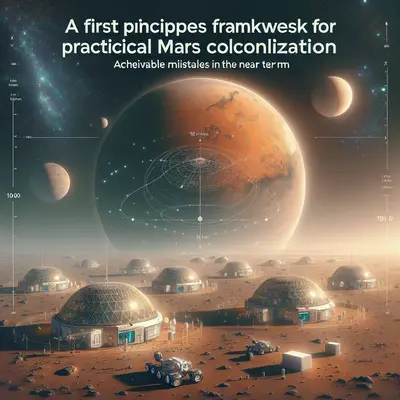A First Principles Framework for Practical Mars Colonization: Achievable Milestones in the Near Term
Abstract
This paper applies first principles reasoning to outline the fundamental requirements for human colonization of Mars, emphasizing practical, near-term solutions achievable with current or near-future technology. By deconstructing the challenges into basic physical, biological, and engineering needs—such as life support, resource utilization, and habitat construction—we identify actionable steps that prioritize rapid implementation over speculative advancements. Key focus areas include transportation, in-situ resource utilization (ISRU), and sustainable habitats. Sources from NASA and SpaceX inform the analysis, with gaps highlighted for further research.
Introduction
Colonizing Mars requires addressing the planet’s harsh environment from first principles: Mars has a thin CO2 atmosphere (about 0.6% of Earth’s pressure), average temperatures of -60°C, high radiation exposure, and 38% Earth gravity. First principles dictate starting with human survival basics—oxygen, water, shelter, and energy—before scaling to self-sufficiency. This approach avoids over-reliance on unproven tech, focusing on iterative improvements using existing launch capabilities like SpaceX’s Starship (SpaceX Starship) and NASA’s Artemis program insights.
Transportation and Initial Landing
The foundational step is reliable, cost-effective transport. From first principles, we need vehicles capable of carrying 100+ tons of payload to Mars orbit, followed by safe entry, descent, and landing (EDL). Current tech like the Falcon Heavy has demonstrated Mars-capable trajectories, but Starship’s reusability enables frequent missions, reducing costs to under $10 million per ton by 2030 estimates (NASA Humans to Mars).
Practical Achievements
Launch windows every 26 months allow initial uncrewed cargo missions in 2024-2026 to preposition supplies. EDL can use supersonic retropropulsion, proven in NASA’s Perseverance rover landing (NASA Perseverance). Quick wins: Develop autonomous landing sites near equatorial regions for solar access.
Habitat Construction and Radiation Shielding
Humans need pressurized, radiation-protected shelters. Mars’ surface radiation is 200-300 times Earth’s due to no magnetic field and thin atmosphere; first principles require 5-10 g/cm² shielding equivalent to Earth’s atmosphere.
Practical Achievements
Use inflatable habitats like Bigelow Aerospace modules, deployable via Starship, covered with 1-2 meters of regolith for shielding—achievable with robotic rovers scooping local soil. 3D printing habitats from regolith-sulfur concrete is feasible; NASA’s 3D-Printed Habitat Challenge demonstrated prototypes (NASA 3D-Printed Habitat). Initial bases: Modular units for 4-6 crew, expandable in 2-3 years post-landing.
Life Support Systems: Air, Water, and Food
Survival hinges on closed-loop systems. First principles: Recycle 95%+ of water and oxygen, as open systems fail due to resupply limits (6-9 month transit).
Air and Water
Electrolysis of water for O2 and H2, combined with Sabatier reactors for CO2 conversion to methane/oxygen using Martian atmosphere. NASA’s MOXIE experiment on Perseverance produced oxygen at 6g/hour, scalable to crew needs with solar power (NASA MOXIE). Water from polar ice or hydrated minerals via heating—initial extraction rates of 1-5 liters/day per unit practical with microwaves.
Food Production
Hydroponics and aeroponics in LED-lit greenhouses yield 10-20 kg/m² annually; potatoes and leafy greens viable in Mars gravity simulations. Initial reliance on stored food for 1-2 years, transitioning to 50% local production via vertical farms—tested in HI-SEAS analog missions (NASA HI-SEAS).
Energy Generation
Power is essential for all systems. Mars receives 40% Earth’s solar flux; first principles favor solar over nuclear for quick deployment, despite dust storms.
Practical Achievements
Deploy 100-500 kW solar arrays upon landing, using Perovskite cells for efficiency (25%+). Kilopower fission reactors (10 kW units) provide baseload, with NASA prototypes ready for Mars by 2028 (NASA Kilopower). Hybrid systems ensure 24/7 operation, scalable in phases.
Resource Utilization and Economy
ISRU minimizes Earth dependence. Extract water, oxygen, and propellants from regolith and atmosphere for return trips.
Practical Achievements
Produce 1-10 tons of methane/oxygen propellant per year initially via electrolysis and Sabatier, enabling fueled returns. Mining regolith for metals supports tool-making; robotic precursors in 2026 can validate yields.
Challenges and Health Considerations
Microgravity en route and low gravity on-site risk bone loss and muscle atrophy. First principles: Exercise regimens and pharmaceuticals mitigate, but long-term effects unknown.
Practical Achievements
Centrifuge modules in transit for 1g simulation; on Mars, suits and habitats with artificial gravity via rotation (small-scale feasible). Psychological support via telepresence with Earth.
Conclusion
A practical Mars colony timeline: Uncrewed landings by 2026, crewed by 2030, self-sustaining outpost by 2040. This first principles path leverages iterative tech like Starship and ISRU, focusing on quick wins in transport, habitats, and life support. Further research is needed to bridge gaps, ensuring feasibility.
